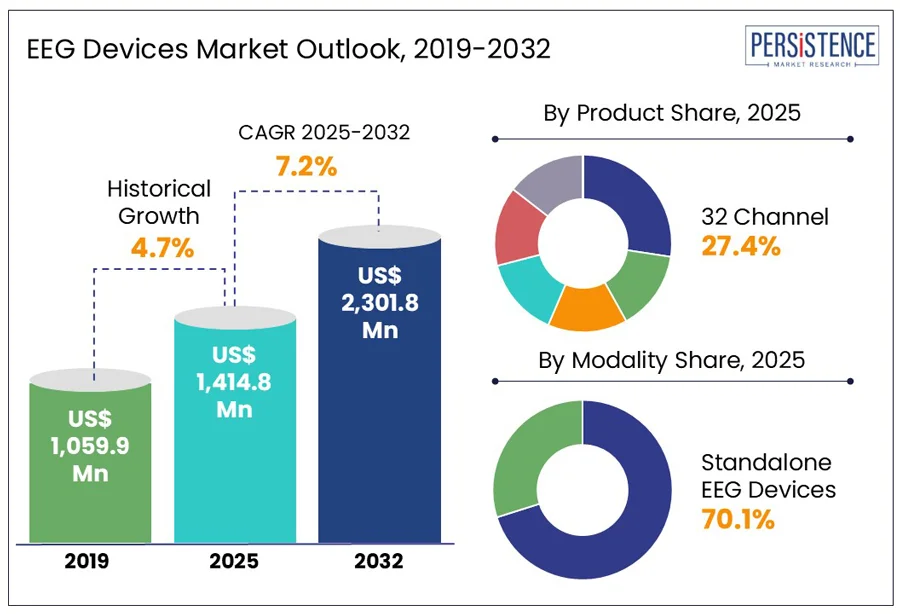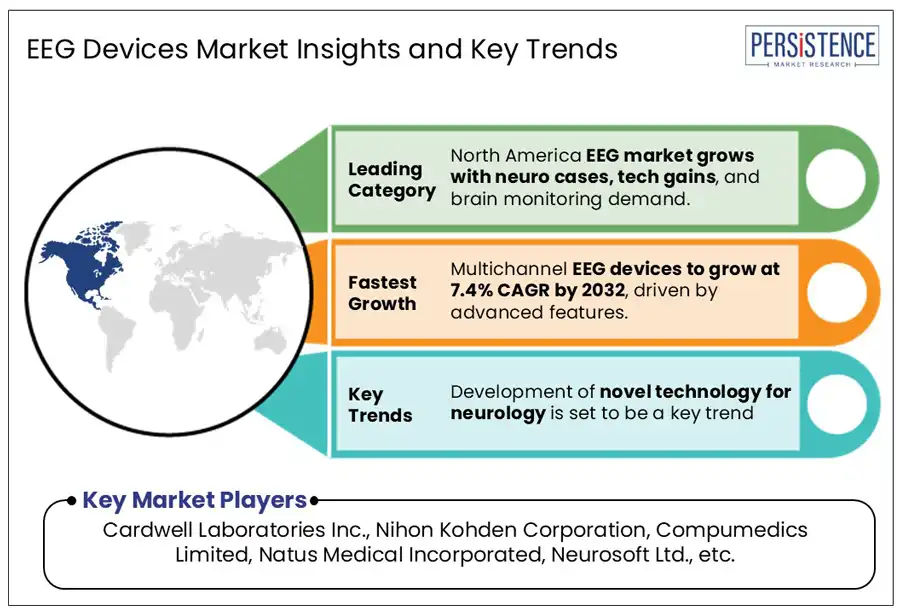ID: PMRREP7616| 184 Pages | 16 Jun 2025 | Format: PDF, Excel, PPT* | Healthcare

The global EEG devices market is estimated to reach US$1,414.8 million in 2025. It is predicted to rise at a CAGR of 7.2% through the assessment period to attain a value of US$2,301.8 million by 2032.
The EEG devices market is skyrocketing as these tools help analyze brain activity and treat neurological disorders. As the global population ages, more people are developing conditions like Alzheimer’s, epilepsy, and Parkinson’s disease. For example, in 2024, over 55 million people worldwide will have dementia. This shows a rising need for novel diagnostic tools like EEG devices.
Neuroelectrics introduced a portable EEG headset in April 2023, enhancing accessibility and real-time remote monitoring for at-home diagnostics, highlighting the surging role of EEG in healthcare. In October 2024, the Mayo Clinic and an AI start-up collaborated to introduce an AI-enhanced EEG analysis platform, enabling quicker and more accurate neurological anomaly detection.
The importance of mental health is increasing, which is leading to the use of EEG devices. For example, Emotiv's Insight EEG, launched in September 2023, focuses on stress management and cognitive health.
The device targets a wide audience beyond just clinical settings. With strong research and development and good funding, the market is set to rise consistently. These devices aim to tackle important health issues and promote mental well-being through innovative and accessible solutions.

Key Highlights of the Market
|
Market Attributes |
Key Insights |
|
EEG Devices Market Size (2025E) |
US$ 1,414.8 Mn |
|
Market Value Forecast (2032F) |
US$ 2,301.8 Mn |
|
Projected Growth (CAGR 2025 to 2032) |
7.2% |
|
Historical Market Growth (CAGR 2019 to 2024) |
4.7% |
In 2025, North America will likely account for 42.3% of the global sleep and neurodegenerative disorder diagnostics industry share, due to the rising incidence of sleep and cognitive disorders. The U.S. EEG devices market is expanding rapidly, driven by rising neurological conditions and advanced healthcare infrastructure. According to the Alzheimer's Association Report, approximately 6.7 million Americans were living with Alzheimer’s disease in 2023, projected to nearly double by 2060. Additionally, around 3.4 million people in the U.S. live with active epilepsy. The growing elderly population, increased awareness of mental health, and the adoption of portable and wireless EEG systems are accelerating market growth. Supportive reimbursement policies and increased R&D investments further fuel demand. Technological advancements like AI-integrated EEG solutions are also improving diagnostic accuracy and expanding clinical and home-based applications nationwide.
North America's robust healthcare ecosystem and leading role in diagnosing sleep and neurodegenerative disorders drive market growth and innovation.
Europe's 26% share in the global EEG devices market in 2025 is due to the increasing prevalence of cognitive disorders like Alzheimer's and dementia.
The European Union (EU) announced funding for neurological research in February 2024. This funding is speeding up the use of EEG devices in clinics. Such developments show Europe’s dedication to improving neurological health and support the continued growth of the market.

In 2025, the 32 channel EEG segment acquired a market share of 27.4% due to its superior diagnostic capabilities and improved spatial resolution. This reflects a shift toward comprehensive brain monitoring solutions.
Multichannel EEG devices, which hold a 13% market share, are essential for supplying large amounts of data for intricate neurological studies in both clinical and research settings.
In 2025, standalone EEG devices are set to dominate with a market share of 70.1% due to the increasing prevalence of neurological disorders like Alzheimer's and dementia. With over 55 million people living with dementia globally, healthcare providers are prioritizing new diagnostic tools.
Portable EEG devices are anticipated to account for 30% of the market share in 2025, particularly in remote and home-based care. For example,
Electroencephalography (EEG) devices are crucial for diagnosing neurological disorders like epilepsy, Parkinson's, and Alzheimer's. The need for precise diagnosis tools like EEG is surging since more than 65 million individuals worldwide will have epilepsy by 2024. These tools are used to optimize anesthetic doses in clinical settings and for the monitoring of sleep disorders.
The elderly population is more likely to suffer from neurological diseases as their cells deteriorate with age. This group is a key reason for the growth of the EEG industry.
New portable products are changing the neurological healthcare sector. For instance,
EEG gadgets are becoming more adaptable due to developments in AI integration and remote monitoring. These are guaranteeing their vital function in contemporary neurology and mental health treatment.
The global EEG devices market recorded a CAGR of 4.7% in the historical period from 2019 to 2024. Neurological services have been severely affected by the COVID-19 pandemic. For instance,
The growing prevalence of neurological problems and cardiac ailments is driving growth in the market for electroencephalography equipment. Given the increasing prevalence of neurological illnesses worldwide, the market is anticipated to increase rapidly.
Development and introduction of new products, such as Masimo's SedLine pediatric EEG sensor and Myneurva's Starrbase, are fueling market expansion. Demand for EEG devices is estimated to record a considerable CAGR of 7.2% during the forecast period between 2024 and 2031.
Neurology is advancing technologically to understand brain functions and tackle complex diseases. It is using real-time brain feedback systems and unique EEG devices to transform brain-behavior relationships. For instance,
Companies like NeuroPace and Medtronic are extending their distribution networks to ensure access to innovative diagnostic and therapeutic solutions. As research and development continue to bridge gaps in neurological care, neurology is a critical area for addressing global health challenges and improving quality of life.
The growing need for non-invasive diagnostic techniques is driving the use of EEG devices, which offer a painless and efficient method for monitoring brain activity. EEG devices, using scalp electrodes, provide precise data on neural function, ensuring patient comfort. These are also considered valuable in clinical and research settings for monitoring brain disorders like epilepsy, sleep disorders, and Alzheimer's disease.
EEG technology continues to revolutionize neurological diagnostics and patient care as non-invasive techniques gain safety and versatility.
Small-scale healthcare institutions may find it difficult to implement EEG equipment due to their high cost, especially for sophisticated 32 channel systems. Although these gadgets provide thorough insights into how the brain works, their exorbitant prices may be unaffordable.
The stringent reimbursement laws for EEG services deter medical practitioners from using EEG in their clinics. This restriction affects patients' ability to get the testing they need.
Quick EEG technology testing across hospitals has brought attention to issues with these cutting-edge gadgets' cost and efficiency. Notwithstanding their promise for neurological disorder diagnosis, widespread access and industry expansion are still hampered by their high costs and reimbursement issues.
Demand for diagnostic tools like EEG devices, is being driven by increased incidence of mental health issues in the U.S., where 1 in 5 persons suffer from them. These devices can be combined with machine learning algorithms to assess brain activity. For example,
EEG technology is anticipated to be increasingly used in clinical and research settings because of the rising awareness of mental health issues and the necessity of early treatments.
Demand for electroencephalography equipment is rising owing to ongoing product introductions and innovations. For instance,
The market is anticipated to develop at a fast pace as more sophisticated and adaptable EEG systems are used by healthcare providers.
Leading companies in the market are increasingly prioritizing innovative product launch strategies to broaden their product portfolios. By diversifying their offerings, they seek to achieve greater success in a competitive landscape.
To effectively address the evolving needs of their customers, leading organizations are actively pursuing a variety of strategies, including the development of new products and the execution of expansion projects aimed at fulfilling unmet consumer demands. This proactive approach is vital for ensuring sustained success and relevance within their respective industries.
Recent Industry Developments
The market size is set to reach US$2,301.8 million by 2032.
EEGs measure brain activity, aiding epilepsy detection, dementia research, and monitoring.
In 2024, Europe is set to attain a market share of 26%.
In 2025, the market is estimated to be valued at US$1,414.8 million.
A few of the key players in the market are Cardwell Laboratories Inc., Nihon Kohden Corporation, and Compumedics Limited.
|
Attributes |
Details |
|
Historical Data/Actuals |
2019 – 2024 |
|
Forecast Period |
2025 – 2032 |
|
Market Analysis Units |
Value: US$ Mn, Volume: As applicable |
|
Key Regions Covered |
|
|
Key Market Segments Covered |
|
|
Key Companies Profiled in the Report |
|
|
Report Highlights |
|
|
Customization and Pricing |
Available upon request |
By Product
By Modality
By End User
By Region
Delivery Timelines
For more information on this report and its delivery timelines please get in touch with our sales team.
About Author